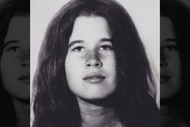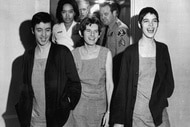Create a free profile to get unlimited access to exclusive videos, breaking news, sweepstakes, and more!
The Chilling Alphabet Murders Still Haunt Police 50 Years Later
In the early 1970s, three young girls were grabbed in broad daylight mere blocks from their homes in upstate New York.

The puzzling case of The Alphabet Murders has stumped investigators for more than 50 years.
In the early 1970s, three young women were murdered in Rochester, New York but within years, their cases went cold. While several individuals have been eyed as suspects, no one has been arrested and convicted with any of the murders. Even with the advent of DNA fingerprinting and incredible advances in criminal profiling, investigators are no closer to learning who was behind savage killings, meaning the perpetrator is potentially still at large.
That being said, authorities have not given up on solving the case. "The thought that we would be able to solve this someday is always there and keeps us going quite a bit," State Police Investigator Thomas Crowley told the Democrat & Chronicle in 2009.
Today, four law enforcement agencies continue to follow-up leads, in the hopes of giving the victims' respective families closure.
Keep reading to learn more about the Alphabet Murders...
What are The Alphabet Murders?
From 1971 to 1973, Carmen Colón, Wanda Walkowicz, and Michelle Maenza were each separately abducted, strangled, sexually assaulted, and dumped in brushy embankments near busy roads outside of Rochester, New York. In a strange twist that no one saw coming, police believe the victims were stalked and chosen for their matching “twin” initials. The outlying towns where the bodies were found also match their initials — Colón in Churchville, Walkowicz in Webster, and Maenza in Macedon — inspiring the terrifying moniker, The Alphabet Murders or Double-Digit Murders.
The girls shared more than just matching double initials. All three came from financially struggling families with absent or deceased fathers, were Catholic, had trouble making friends in school, and one was believed to have learning disabilities, according to a 1973 New York Times article. Moreover, they were all blocks from their homes when they disappeared.
Who was Carmen Colón?
Carmen Colon was a 10-year-old Puerto Rican girl who spoke little English and lived with her grandparents in Rochester. She often ran errands in the neighborhood for her grandfather, Felix Colón.
At 4 p.m. on November 16, 1971, she walked two blocks to a pharmacy to pick up a prescription for her grandfather, reported the Statesman Journal. While waiting for the prescription, she left the drugstore and never returned. Carmen was spotted one last time about an hour later on Route 490 West, about 12 miles away from her neighborhood. Witnesses say she was nude, waving her arms, and running away from a car backing up on the shoulder of the road, according to the Statesman Journal.
“Would you believe it, nobody stopped,” Police Captain Andrew Sparacino told The New York Times in 1973. “People told us they were going too fast; they were in a hurry to get home.”
"I know they feel horrible (they didn't stop) and they were courageous enough to come forward after the fact," Monroe County Sheriff's Office Investigator Patrick Crough told the Democrat & Chronicle in 2009. He additionally noted that cell phones were not in use, so no one could've quickly called for help.
Two days later, two teenage boys on bicycles near Churchville, about 35 miles southwest of Rochester, found her lifeless naked body in a ditch alongside a road, at first thinking it was a “broken doll,” according to newspaper reports. The autopsy results revealed she had been raped and strangled by hand.
RELATED: A Look Back at the Murder of Katie Sepich and the Creation of Katie's Law
What happened to Wanda Walkowicz?
Wanda Walkowicz was 11 years old at the time of her death. Rita DeCann told the Democrat & Chronicle that her older sister was a tomboy with red hair and weighing 65-pounds. She often helped her mother with tasks like purchasing groceries for dinner, as their father had died of a heart attack years earlier.
On April 2, 1973, 11-year-old Wanda Walkowicz walked to the grocery store by herself on the east side of Rochester at around 5 p.m. Wanda bought some groceries nearby and started to walk north on Conkey Avenue, according to the store owner. A witness spotted her near the market about an hour later, holding her groceries and hesitating at the door of a stopped car.
The next day, at 10:15 am, a New York State Trooper found her fully-clothed dead body at the bottom of a hillside at a rest area off State Route 104 in Webster, about fifteen miles northeast of her home. Autopsy results showed she was strangled by a belt or a similar ligature, sexually assaulted — and chillingly, fed before she was murdered.
The then-Police Captain Andrew Sparacino told The New York Times he believed the killer had a car, and the girls entered it willingly, “The lure dangled before the children may have been the offer of a hamburger and a soft drink.”
According to the Real Crime documentary, cat hair was found on Wanda’s clothes even though the family did not own a cat, leading to speculation that the killer enticed her with an animal.
Relatives who visited Wanda’s gravesite told Real Crime that for 15 years, an unknown visitor had been cleaning her gravestone and placing flowers.
Who was Michelle Maenza?
Months after Wanda went missing, on Nov. 28 1973, 11-year-old Michelle went to her school nurse's office in tears on the Monday after Thanksgiving. The New York Times reported in December 1973: “Michelle and her younger sister were tormented by their classmates because they obviously were not required to bathe regularly and their clothing was ragged and dirty.”
The nurse let her leave school, and she was last seen about a fifth of a mile from campus by classmates, reported the Democrat & Chronicle newspaper in 1973. Police received a tip that a girl who looked like Michelle was spotted at a hamburger stand in a man’s car. The witness said the man had “dirty hands” and returned to the car carrying a bag and a cup, according to Real Crime. Witnesses later saw a similar looking man driving a car with a flat tire, as well as a girl matching Michelle's description in the backseat, according to the 2009 Democrat & Chronicle report. Witnesses told the police what the man looked like, providing the first description of a possible suspect.
Two days later, Michelle’s lifeless, clothed body was in a ditch in plain sight in Macedon, about 20 miles northeast of Rochester. She had been strangled with a ligature, and the autopsy revealed she had eaten a burger at some point before her death.
Steve Maenza, her brother, later told the Democrat & Chronicle in 2009 that his uncle had seen Michelle the day she went missing and offered her a ride, which Michelle declined. "It must have been shortly after he left the guy picked her up. My uncle was kind of upset with himself for many years because he didn't pick her up," Steve said.
Have The Alphabet Murders been solved?
Over the past half-century, one investigation after another has led nowhere. At one point, police believed Carmen had a separate killer from the other two girls due to differences in how she was strangled (bare hands) and her state of dress when found (mostly nude). The main suspect was her uncle, Miguel Colón, but after a domestic dispute, he committed suicide by gunshot in front of police and is now thought unlikely to be the murderer, the Democrat & Chronicle reported. The Colón family maintains his innocence.
The infamous Hillside Strangler, Kenneth Bianchi, who terrorized Los Angeles between 1977 and 1979, was once in the police crosshairs for the Alphabet Murders. A former ice cream vendor born and raised in Rochester, he moved to Los Angeles and was convicted of a series of rapes and strangulations, dumping his victims’ bodies on hillsides throughout LA. Former FBI profiler Roy Hazelwood told Real Crime that a palm print found on Michelle’s body didn’t match Bianchi, but some still believe he may be the culprit.
Joseph Naso, another “double-initial killer” hailing from Rochester, was convicted of four brutal murders of Northern California prostitutes between the 1970s and 1990s. All of the women had matching initials. Eerily, one of his victims had the same name as the 10-year-old girl: Carmen Colón. However, the DNA evidence from the Rochester killings does not match Naso’s.
In 2009, police even exhumed the corpse of a city firefighter suspected of being a serial rapist to compare his DNA with that from a crime scene, but the case remains cold and no further updates have been publicly disclosed.
While 2023 marks the 50th anniversary of these horrific murders, police and investigators refuse to lose hope. Anyone with information is asked to call the New York State Police at (585) 398-4100 or e-mail the information to: nysvicap@troopers.ny.gov.



























